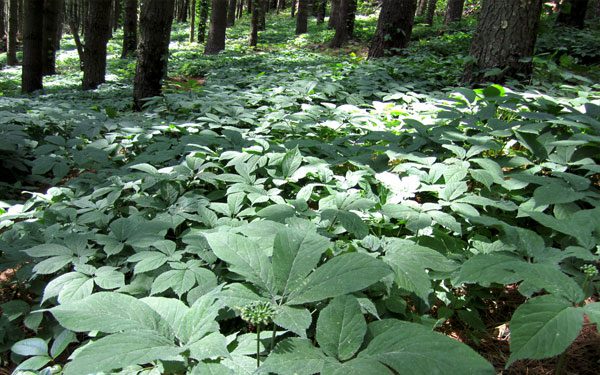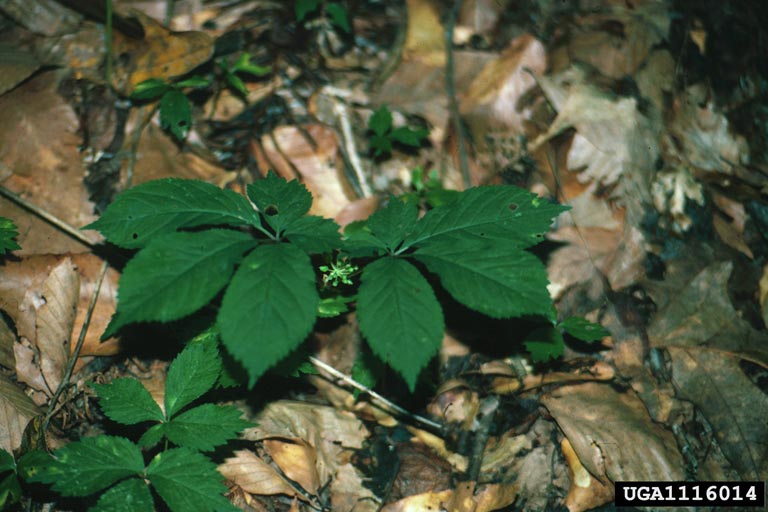Forestry

Ginseng (Panax quinquefolius) is a slow-growing woodland plant that is native to Alabama. Roots of wild ginseng have been dug for centuries in the region. Ginseng is known for fetching high prices per pound. Most of it is currently exported to east Asia, where it—as well as Asian ginseng (Panax ginseng)—has been a valued medicine for thousands of years.
Forest farming ginseng offers patient forest owners an opportunity to produce a high-value, low-input forest crop, while contributing to the restoration of this threatened native species. However, because this plant has been overharvested in Alabama, it is now regulated by the state. Individuals must obtain a permit from the Alabama Department of Agriculture and Industries to harvest, grow, or sell ginseng.
Suitable Habitats

Figure 1. Forest farming ginseng. (Photo credit: High Country Ginseng, NC)
Ginseng is most associated with Appalachia but has been found naturally occurring as far south as the Black Belt in Alabama. To grow, ginseng needs 1,000 hours of temperatures below 50 degrees F, annually. Ginseng is picky about growing locations and will not be successful in every forested location or every region of Alabama. It prefers cove-hardwood areas facing to the north or northeast that have approximately 70 percent shade and a soil pH between 5 and 6. Species such as tulip poplar and black walnut—along with trillium, bloodroot, and cohosh—may indicate a suitable planting location. In an unsuitable site, ginseng may germinate but will ultimately languish and be unproductive.
Planting
Methods for growing ginseng can be divided into three categories: field grown, woods grown, and wild simulated.
Field-grown ginseng is grown under shade cloth in dense rows with fertilizer and regular fungicide applications. This method has the highest expense, lowest value, and quickest time to harvest.
Woods-grown ginseng is planted into tilled forest beds under natural shade, yielding medium-value roots and an intermediate time to harvest.
Wild-simulated ginseng is planted into untilled forest soil, yielding the highest-value roots. To prepare a wild-simulated ginseng patch, thoroughly clear the understory vegetation and rake away the leaf layer. Plant at a rate of 1 ounce of seed per 100 square feet into at a depth of 1 inch. To ensure good seed-to-soil contact, pack or push the seeds in and reapply leaf litter mulch or high-quality compost. Growers will be most successful with this method by planting seeds that are grown with wild-simulated practices. Note: Seeds can take up to three years to germinate.
Life Cycle

Figure 2. American ginseng. (Photo credit: Charles T. Bryson, USDA Agricultural Research Service, Bugwood.org)
Ginseng goes through distinct stages of plant form before reaching reproductive maturity and a suitable harvest age. Seedlings emerge with three leaflets, and after 1 year of growth, they typically obtain five leaflets, known as stage class one or one prong. Stage-two plants have obtained two leaves, each with typically five leaflets. Three-prong plants are the youngest stage appropriate for harvest. Leaving three-, four-, and five-prong plants within a patch is necessary for growers or collectors relying on natural-seed dispersal.
Diseases and Pests
Ginseng is relatively resistant to insect and disease pressure when grown with the wild-simulated method. Growers may encounter issues with fungal pathogens such as alternaria leaf blight or phytophthora root rot disease. Wildlife—such as deer, turkey, and voles—can cause damage, and human poachers can be a concern. Preventing deer from accessing the site or applying a repellant will lead to the best results.
Harvest
State permits to harvest wild or wild-simulated ginseng only allow for collection and sales at certain times of year. It is important to understand whether you are considered a collector or grower. Stay up to date with your permit and any regulations from the Alabama Department of Agriculture and Industries.
Wild-simulated ginseng typically takes 8 years to grow before it is suitable for harvest as a high-value root. Ginseng must have at least three five-leaf prongs to be of legal harvest age. This can be verified by inspectors based on root neck form. Hand harvest carefully to maintain fine-root structures. Then, dry the plants at 80 degrees F in a location that has indirect sunlight and good airflow for several weeks.
To harvest seed as a grower, collect red fruits in late summer or early fall. Separate the seeds from pulp and store them in slightly wet sand for cold stratification before replanting in prepared beds. For collectors, any ripe seed from harvested plants must be immediately replanted on site. Collecting plant roots prior to their seed dispersal contributes to extinction.
Conclusion
Starting a ginseng patch is a risk, requires patience, and is only suitable for some sites in Alabama. For hardwood-forest owners that are willing to contribute to its preservation, growing with the wild-simulated method is ecologically sound, produces one of the highest-value crops per pound, and preserves the tradition of stewarding native, edible plants.
